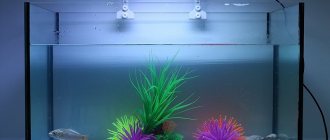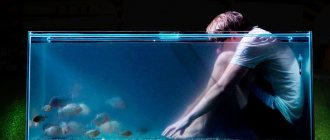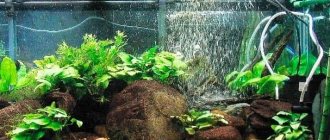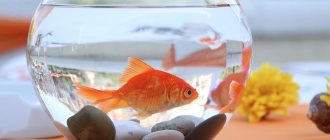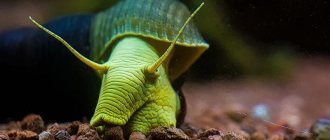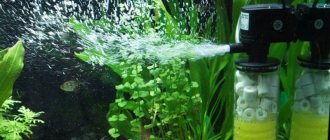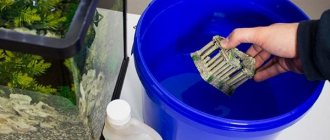Is it possible to turn off the compressor in an aquarium at night?
It is very difficult to say definitively whether to turn off the compressor in an aquarium at night, since it depends on several factors that influence the decision. For some aquariums, turning it off in the morning will not bring any unpleasant consequences, but for others, turning off aeration even for a few hours is not recommended.
Let's figure out when it is permissible to stop forced aeration at night, and when it is better to refrain from such a decision.
Varieties
The main classification divides compressors for aquariums into the following groups: membrane, piston and pumps. They differ in operating principle, noise level and price.
Piston
The principle of operation is the movement of the piston, with the help of which air is pushed out. The rotational movements of the piston shaft become oscillatory. Such changes help to achieve the required air supply power. This is an ideal compressor for an aquarium that is located in the bedroom, as it produces minimal noise, but is more expensive than a membrane one.
The advantages are:
- durability;
- almost silent operation;
- high performance;
- can be used for large aquariums.
The disadvantages of these devices are as follows:
- high energy consumption;
- high cost.
Membrane
The principle of operation is the movement of air from a chamber connected to the membrane due to pressure differences, which are created due to vibrations of the magnet.
Pros of this device:
- low energy consumption;
- easy repairs;
- cheapness.
The disadvantages of these devices are as follows:
- low power;
- loud noise during operation.
We take into account the details
The following factors must be taken into account:
- dimensions and shape of your aquarium;
- population of fish and snails;
- presence of algae in the aquarium;
- decorating elements.
The numerical characteristics of the water surface depend on the dimensions of your aquarium. The larger the space, the better the exchange of gases between living organisms and the external environment. In this case, the fish have excellent conditions for life, and the compressor also additionally regulates the oxygen supply.
Thus, it is always recommended to have, if not a huge, then a significantly larger aquarium than is required for the number of free-swimming fish. The larger the tank's capacity, the less likely it is that your pets will experience oxygen deprivation at night if you plan to turn off the oxygen supply compressor. Try to avoid crowding in the aquarium by any means - remove growing plants, purchase a larger aquarium.
And if there is an overpopulation of fish, then remove them from the existing composition, leaving only the normalized number of individuals.
I bought an aquarium and fish. I don’t know how hard the compressor should work
Mr. Sigismund
1. There is never too much air. Simply select the compressor for the volume of the aquarium. I actually have three of them and they all download. The fish have not complained yet)) ) 2. It is better to remove the lamp, because a) water blooms from light; b) the water heats up, which is critical for fish; c) daylight is quite sufficient. 3. At night the fish sleep. This is completely normal.
Alex
Wow! There are 19 fish in 17 liters! Is there room left for water? About 5 small fish is enough. For one scalar you need 50 liters! Just leave the guppies, everything will be ok! The compressor should work constantly, but not too hard so that the fish are not tossed around the aquarium!
Kondraty Prikhodov
Scribe to the fish... Remove the aquarium (actually a hatchery for fry). In its place, put at least a 50-liter filter (so as not to throw away the filter), and leave the fish the same. Angelfish in such a volume (17 liters) will not survive. This “aquarium” can be used as a shrimp tank or for a dozen guppies or neons, but it will bring immeasurably more hemorrhoids than a 100-liter jar, because the biological balance in this glass is very difficult to establish, and it’s easy to disturb! Which has already been done by so many illiterately selected fish. And the fact that the water is cloudy is not a big deal in the first few days...
Risk factors
It is very important to avoid overcrowding, and this depends on how large your aquarium is . If you turn off the air compressor at night in an aquarium teeming with fish, then in the morning there is a high probability of finding several individuals dead from lack of oxygen. This is explained by the fact that there is less oxygen per individual in an aquarium with a non-working compressor, and if it is overcrowded, then the chances of oxygen starvation increase several times.
During the day, the algae in the aquarium produce oxygen during photosynthesis, but at night the situation changes dramatically - at this time of day, plants, on the contrary, begin to consume oxygen from the water. Therefore, it is logical to assume that even in a not particularly densely populated aquarium, the night life of the fish is complicated.
How many hours a day should a filter-compressor work in an aquarium?
and I bought myself a time relay and set the program - hour of work - hour of rest during the day. At night he works for an hour and a half and rests for half an hour. I monitored the oxygen content in the aquarium for a day and was able to choose this mode. Look, if the fish are just starting (Watch carefully! DO NOT allow oxygen starvation!) to move closer to the surface (but not to eat or for some other obvious reason) - then turn on the aeration. It is IMPOSSIBLE to keep the compressor on all the time! This is constant vibration, and it is very harmful! The compressor can be turned on around the clock only in one case - if the filter is external, that is, vibration is not transmitted to the aquarium. It is recommended to install a check valve even before a conventional sprayer to reduce noise. This heater with a thermostat must be turned on constantly, but the compressor must be turned on only when needed! Ideally, you shouldn’t have any equipment AT ALL in your aquarium! It is better not to overpopulate the aquarium and choose the right ratio of plants and fish, as well as respect the length of daylight hours.
Elena Gabrielyan
The filter with the aerator must operate continuously without shutting down (24 hours a day) and turn off only during washing. You also need to take into account the starting torque of the equipment - constant switching on and switching off will quickly lead to the equipment burning out.
Why turn it off?
Turning off the compressor at night can have various reasons - the owner wants to save energy or does not consider it necessary to operate it at night, believing that the fish are sleeping.
However, you must understand that keeping any pets involves various expenses, so even before purchasing animals, you need to think about whether you are ready for additional expenses for maintaining living creatures . Fish need their own aquarium, additional lighting and aeration, food and plants that make their daytime existence easier.
If you have a lot of fish and the aquarium looks overcrowded, you should be prepared to purchase a second one and remove the fish to avoid crowding and the risk of the fish suffocating.
In other cases, when you have a spacious aquarium with a minimum of vegetation, you can sometimes turn off the compressor at night, but be sure to monitor the reaction of the fish in the morning. It is easy to understand whether they have enough oxygen by paying attention to where the fish swim. If they hovered close to the surface of the water, it means that at night they actively swam up to swallow air.
How long a day should an aquarium compressor run?
Konstantin Bogdanov
Depends on the population of the aquarium and its population of fish and plants. If the aquarium is normally populated with plants and fish are present in small numbers, then it is not at all necessary to aerate the water around the clock. Can determine the operating time of the compressor itself. Turn off the compressor and monitor the behavior of the fish; if the fish begin to rise to the upper layers of the aquarium, much less grab air from the surface, immediately turn on the compressor. Based on these data, draw a conclusion about the operating time of the compressor. If you have a filter with an aeration function, it is better not to turn it off at all. It's easier this way for many reasons. It is highly advisable not to turn off the compressor at night. Although the oxygen consumption of sleeping fish decreases (however, there are nocturnal species), nevertheless, in the dark, plants emit carbon dioxide instead of oxygen. So, without aeration in an aquarium densely planted with plants, fish have a high chance of not surviving until the morning when aeration is turned off. As a rule, beginners outrageously overpopulate their aquariums and prefer to shove plastic Chinese garbage into aquariums instead of living plants, so I usually strongly recommend that beginners do not turn off either the compressor or the filter at all.
Natalya A.
If you have a filter with aeration 2 in one 24 hours a day, turn it off only for washing when it gets dirty, if the compressor is separate, then you need more detail - are there living plants, fish stocking density.
You can turn off the filter in the aquarium at night
Despite the fact that fish living in an aquarium are designed to entertain and pacify their owner with their external appearance, one should not forget that they are living beings living according to the laws of nature. Let us remember that fish naturally live in water, rivers, ponds and other bodies of water. Of course, we all understand that at the bottom of a natural reservoir it simply cannot be as light and bright as in an illuminated aquarium. By and large, the fish themselves do not need light at all. Light is needed only for two purposes:
- Firstly, thanks to the backlight, you can see your pet;
- Secondly, if there are living plants in the aquarium, they need light in order for the plants to undergo the process of photosynthesis.
In nature, light also does not penetrate the water column around the clock and does not illuminate the bottom continuously. Therefore, having a backlight, it is necessary to purchase a light timer in the aquarium. After all, there is no need to leave the lamp on at night. In order not to forget to carry out the change of day and night, a timer is suitable.
For fish, by and large, it doesn’t matter whether there is light in the aquarium or not; the most important thing for them is that there is a comfortable temperature near the water in which they live and that there is always food for feeding. The purity of water directly for fish is also one of the first places and occupies a more important position than the presence or absence of artificial lighting.
In addition, the light can be turned off not only at night but also during the day. You just need to imagine how lighting occurs in nature. After all, the sun does not shine continuously. Sometimes it is covered by clouds or the weather is simply inclement. So the backlight can generally only be turned on for a few hours a day. Based on the above, it can be noted that the question of whether to turn off the lights in an aquarium is very simple and clear.
It is not only possible but also necessary to turn off the light; you should not illuminate it continuously throughout the day and all night. In addition, a careful attitude towards electricity consumption will have a positive effect on the change in electricity bills at the end of the month.
Even when using energy-saving lamps and operating them around the clock, you can also get an impressive figure in a month. In order for the life in the aquarium to be extended, it is necessary to adhere to the conditions of keeping the fish as long as possible, bringing them as close as possible to natural conditions.
How to make a compressor for aerating water in an aquarium with your own hands
Today, stores offer a huge range of compressors for aeration of various shapes, capacities, and technical characteristics. However, such a device can be quickly and easily assembled with your own hands if you stock up on the necessary tools and materials.
Necessary materials
To quickly and without much difficulty make a homemade aerator, you should take the following set of materials:
- plastic bottle cap;
- a set of holiday candles;
- classic balloon;
- a lollipop stick or any other durable stick;
- an elastic band, for example, a small piece of inner tube from a bicycle;
- several small pieces of plywood and wooden blocks for the base of the structure;
- motor. Any motor with average power that can be powered from an electrical outlet will do, for example, a motor from an old printer. Devices from toys are not suitable, as they have low power;
- any power supply (9 W is enough).
Step-by-step manufacturing instructions
The compressor manufacturing technology is quite simple and consists of the following steps:
- Preparing the balloon. Cut a ball of any color (it is preferable to choose light shades) lengthwise to half to create a continuous sheet.
- Preparing the lid. Using a 3 mm and 6 mm drill, drill two holes in the lid at approximately equal distances from each other. Carefully clean the edges of the lid from burrs using a sharp knife. It is also good to sand the holes made.
- Valve manufacturing. Cut a valve from the soft rubber of the chamber in the shape of a horseshoe. It should be remembered that all subsequent operation of the device will depend on the quality of manufacture of this part. Glue the rubber valve inside the lid, and apply the glue only to the “legs” of the valve, while its “head” should cover the small hole.
- Making a drum. Pull the cut ball on top of the lid so that you get a kind of drum. Secure the ball with tape around its entire circumference. Use scissors to trim off the remainder.
- Compressor base assembly. On a small rectangular piece of plywood, which acts as the basis of the structure, glue blocks on the sides - the legs of the device. Glue a small piece of plywood on top, which will serve as a stand for the motor. Glue the motor onto this stand, and at the bottom of the structure install a connector for connecting the power supply and an on/off button. After installing all the elements, solder the entire circuit.
- Making an eccentric. Cut a small piece 8 mm wide from the hot glue stick. Using an awl, make a hole in the center and a similar hole on the side. Place a small piece of wire in the side hole to create a homemade eccentric. Place this device on the motor shaft.
- Manufacturing of a rotating element. Cut the lollipop stick to 3-4 cm, then glue it into a candle holder from store-bought candles. Cut a side hole at the end of the stick and install the resulting part on the eccentric. Glue the candlestick in the center to the previously prepared drum, and you need to glue it in such a way that the stick does not press on the ball and does not pull it along with it. Fix the drum to the base using hot glue.
- Installation of the tube. In order for air to flow into the aquarium with fish, you should connect a regular rubber tube and a classic adapter, which can be purchased at any hardware store. Screw the adapter into the drum, into the previously made 6 mm hole, and place a tube on it.
The homemade aerator is ready. To supply oxygen, you need to lower the end of the tube into water and turn on the device. The principle of its operation is very simple: as the motor turns, it pulls the membrane behind it, and air enters the lid through the valve.
Familiarize yourself with the features of manufacturing an external filter, phytofilter and siphon for cleaning an aquarium.
Having made half a turn, the membrane is pressed in and pushes out the air, while the valve closes and the air is “forced” to exit through the tube directly into the reservoir.
Video: How to make a compressor for an aquarium with your own hands
Some tips for reducing noise
In order to enjoy a healthy sleep, it is necessary that the noise from the aquarium be as little as possible. Therefore, I give some tips.
- Try not to place an aquarium in the bedroom unless you have figured out how to ensure silence in advance.
- Don't put in too many fish. There should be enough residents so that they can do without air supply.
- Choose silent aquarium equipment if silence is important to you
- If you decide to turn off the air at night, do not feed the fish beforehand. After eating, fish consume more oxygen and, perhaps, in this case there will not be enough air.
- Add live plants to your aquarium. They absorb carbon dioxide and release oxygen.
Common mistakes made by newbies
When installing an aerator, a novice aquarist should know several important aspects. They will help you avoid making mistakes that could subsequently have a detrimental effect on the condition of aquatic inhabitants:
- The water that is driven by the compressor is not enriched with oxygen due to the action of bubbles. O2 saturation occurs not in the water, but above it, and the bubbles, creating wave vibrations, only contribute to the improvement of this process;
- you cannot turn off the aerator at night so as not to disturb the gas exchange balance;
- As you know, warm water contains less gas, so fish try to absorb it in large quantities. This feature can be used to rescue inhabitants of the aquatic environment who have asphyxia - lack of air;
- The normal amount of oxygen in water is 5 mg per 1 liter. This indicator can be measured with a special device or tests, which are available in a wide range in pet stores. You can balance O2 in water using several methods: by regulating the air flow from the compressor, partially replacing the water with fresh water, or by selecting the optimal ratio of fish and plants;
- You can revive a suffocated fish, cure a sick fish, or clean an aquarium of unwanted inhabitants using hydrogen peroxide. However, before using it, you need to carefully study the instructions for use.
Don't underestimate the importance of an aeration system in your home pond. With its help, a gas exchange regime favorable for the life and development of aquatic inhabitants is created, the water is saturated with oxygen, and the bacterial and dusty film that often appears on the surface of the water is destroyed. Only that aquarium will be a real decoration of the apartment, in which safe and healthy living conditions are provided for its inhabitants.
Light in the aquarium
The normal life of aquatic plants and living creatures directly depends on the quality of light. And every novice aquarium fish lover will definitely have questions: is light needed in an aquarium and why is it needed? Let's try to find answers to these questions.
In the old days, fish lovers placed their aquarium next to the window for better lighting. However, they soon noticed that if the light from the window falls on the fish house at an angle, then its walls begin to become overgrown with algae.
Later, with the advent of modern lighting devices, natural light for fish in aquariums was replaced by artificial light.
In addition to its decorative function, light in an aquarium also performs an important physiological function. After all, all living organisms need light for proper development, and its absence causes them stress.
When to turn on the light in the aquarium?
Almost all aquarium fish and plants originate from the tropics, where daylight hours last approximately 12 hours, regardless of the time of year. Therefore, for your aquarium pets it is better to organize the lighting to which they are accustomed in nature.
There is still no clear answer to the question: is it necessary to take breaks in lighting the aquarium? You can turn on the lamps at about 10-11 o'clock in the morning and turn them off at the same hours in the evening. It would be better if you delegate the responsibility of turning on and off the lights in the aquarium to a special timer that will do this even in your absence.
How to calculate the light in an aquarium?
Many aquarists advise setting the light intensity per liter of water - a 0.5 W lamp. At the same time, do not forget to take into account the depth of your aquarium: fish living in deep water will need less light than shallow water ones.
As practice shows, you can select the light specifically for your aquarium experimentally, starting from the average 0.5 W. If there is too much light in the aquarium, the water in it will begin to bloom, and the walls will become overgrown with algae. If there is insufficient lighting, the fish will have difficulty breathing, small-leaved plants in the aquarium will begin to die, and brown spots will appear on the walls.
Light spectrum in an aquarium
How to choose a lamp for an aquarium?
How long a day should oxygen be on in an aquarium?
Michael
Don't harm your fish! Don't deoxygenate the water! A few hours a day is enough! Let's think: in nature, does anyone supply fish with air “always”??? Only fish living near waterfalls receive air around the clock. These waterfalls act as a natural compressor. And in nature, fish receive air produced by aquatic plants. That is, plants in the aquarium won’t hurt either...
